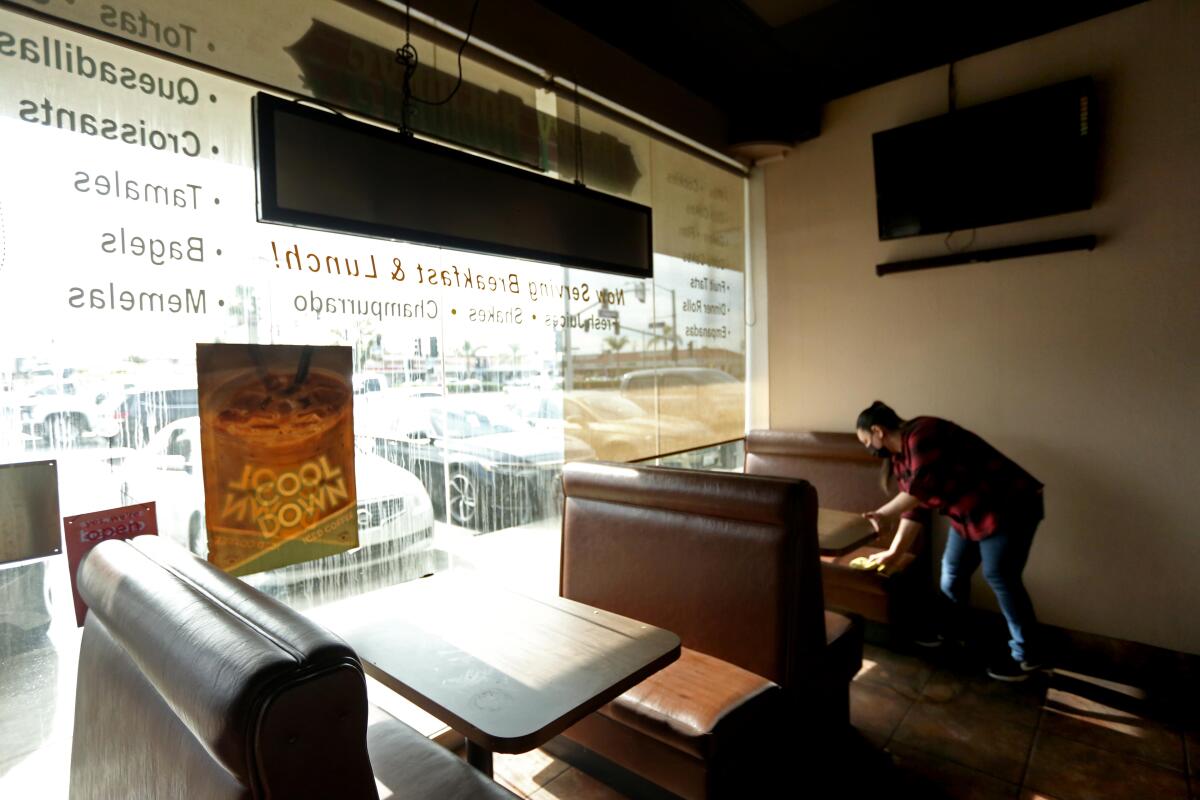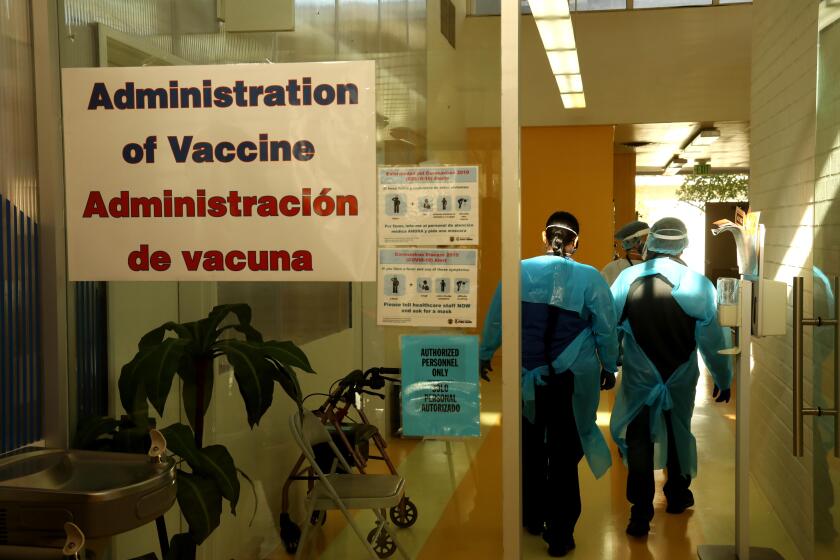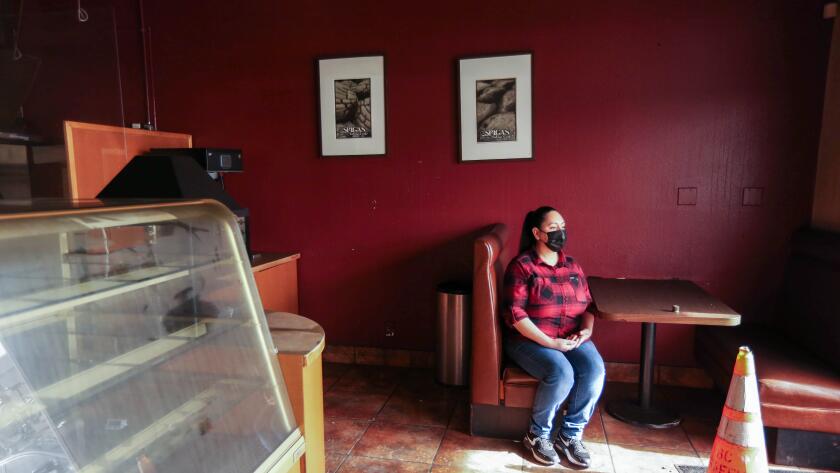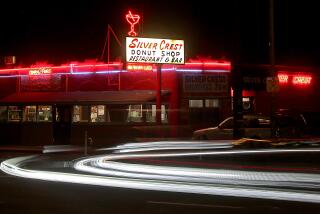Column: Their Mexican bakery weathered COVID-19’s devastation. Can it survive a fire?

Dec. 7 started as a typical, ideal workday for Omar Lopez. He got up at 3:30 in the morning to shower. He nudged awake his wife, Stephanie Ramirez. He checked on their sleeping 12-year-old daughter, Ahtziri. He then left home and drove five minutes away to the family business, Spigas Bakery.
The Mexican panadería had earned a loyal following almost from the moment the small space debuted in 2011. Disneyland-area hotels and restaurants signed up for wholesale accounts; police officers and construction workers would be waiting every morning when Stephanie showed up at 5 a.m. Everyone clamored for Omar’s creations: silky flan, flaky chicken empanadas, powdery pan dulce and a small menu of Mexican breakfast staples like chilaquiles and memelas.
Stephanie — the quiet one — ran the register; Omar — the wisecracker — chatted up customers between rounds of baking, which he did for 14 hours a day, seven days a week. Spigas was the culmination of a promise the two Mexican immigrants had made to each other 25 years earlier, when they met at another panaderia in Santa Ana: Let’s open one on our own, and let’s get our American Dream.
That dream had nearly derailed over the last two years.

The pandemic erased Spigas’ corporate accounts and the life savings of Omar and Stephanie. Regulars couldn’t afford to buy even coffee anymore. Revenue was already down 60% when Omar, Stephanie, and Ahtziri contracted COVID-19 in November 2020 and had to shut down Spigas until they recovered. When it reopened a few weeks later, only Stephanie returned: Omar was in the hospital, intubated and near death.
Spigas turned into a ghost of its former self — Stephanie was terrified of serving anyone at first, because “I thought everyone had COVID.” When Omar finally returned to work last June, he was 60 pounds lighter and “looked like a grandfather,” she said.
Display cases, once groaning with goodies, were now nearly empty. All the employees had left. Omar needed help to do tasks that were once as simple to him as blinking, like taking trays out of ovens or using a rolling pin for more than a few minutes.
But there was never any question of shutting down permanently. “Baking is like therapy for Omar,” Stephanie said.
COVID-19 has been devastating for everyone, but in the United States, there’s one demographic hit particularly hard: Latinos.
He and his wife had weathered a double gauntlet of COVID-19 devastation that has slammed Latinos. The group has been overrepresented in COVID cases and deaths in California since the start of the pandemic — currently, they make up about 39% of the state’s population but 49% of cases and 45.2% of deaths. A survey by the Pew Research Center showed that 60% of Latino households nationwide have seen pay cuts or lost jobs since the pandemic began, compared with 44% of the overall U.S. population.
Spigas was the culmination of a promise the two Mexican immigrants had made to each other 25 years earlier, when they met at another panaderia in Santa Ana.
Through sheer ganas — willpower — Omar and Stephanie brought back their bakery to a sense of normalcy. Debts were paid down; clients returned. Omar bought cornhusks by the bagsful for tamales to prepare for the holidays.
In fact, the 42-year-old initially thought that the lights he saw from a distance, as he approached Spigas on that Dec. 7 day, were a new Christmas display in the shopping plaza Spigas calls home.
They came from firetrucks that blocked off the parking lot.
Omar got out of his car and approached the commander, whom he recognized as a regular. The back of Spigas had burned. When Stephanie showed up soon after, her husband remained inconsolable.
“We were starting to get back up,” Omar told me. We spoke over the phone last week because he couldn’t meet me at their bakery. Though it was almost a month and a half since the fire, smoke still permeated its walls and made it hard for Omar to breathe. Besides, he admitted, he couldn’t stay there for more than a couple of minutes if he went because he would break down in tears.
“We were getting our restaurants back,” he said. “The customers were starting to order again …”
He stayed quiet. “Now? Nothing — nothing.”
I met Stephanie at Spigas because I wanted to see the damage for myself — not just as a reporter, but also as a regular. I had enjoyed their food and smoothies nearly every Saturday morning for years, every time I picked up bagels and croissants so my wife could use them for sandwiches at her restaurant.
The bakery looked fine from a distance when I drove up. The front window still displayed a painted-on “Happy Holidays” and a list of daily specials. But it wasn’t until I walked up that I noticed red caution tape wrapped around the handles of Spigas’ front door, and a heavy chain with a padlock on the other side.
I went around the building to the back, where Stephanie was waiting to show me the damage. There was a torched toilet in the restroom, where firefighters told Omar the blaze started. Water stains dirtied the walls. The booths, which I remembered always packed with people, were eerily quiet.
The smoke’s stench was still so bad that I could only stay inside for a couple of minutes before stepping back outside, even with my N95 mask. The fire had ruined the water, gas, and electrical lines. While the landlord has frozen rent for the foreseeable future, Stephanie estimates it’ll take at least $50,000 to just get to a point where they can decide on whether to continue.
“And then we need to see if any of this works,” she added, waving toward walk-in refrigerators now used as closets and ovens the size of a closet that cost $4,000 for just a regular tune-up.
Spigas had no fire insurance because she couldn’t afford monthly payments after Omar’s hospital stay. They didn’t win any state or federal emergency grants, and didn’t qualify for pandemic loans. “And the bills haven’t stopped,” Stephanie added.
Friends have set up a GoFundMe account to help. But Omar and Stephanie are slowly preparing themselves for the possibility that Spigas may never reopen.
“It makes me want to cry,” said Omar. “That was our future, our life of 25 years working in the United States.”
“To get up for 10 years every day at 4 a.m., and to see this,” Stephanie said as we stood in the parking lot. Tears welled in her eyes.
“Now you wake up and say, ‘What is there to do? What do we do?’ ”
More to Read
Start your day right
Sign up for Essential California for news, features and recommendations from the L.A. Times and beyond in your inbox six days a week.
You may occasionally receive promotional content from the Los Angeles Times.










